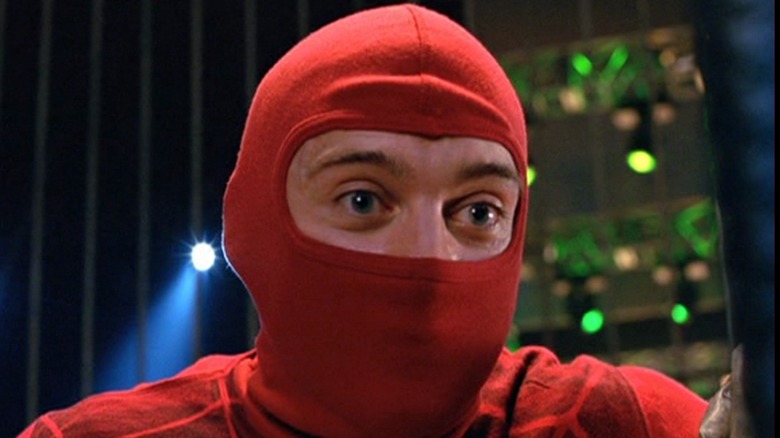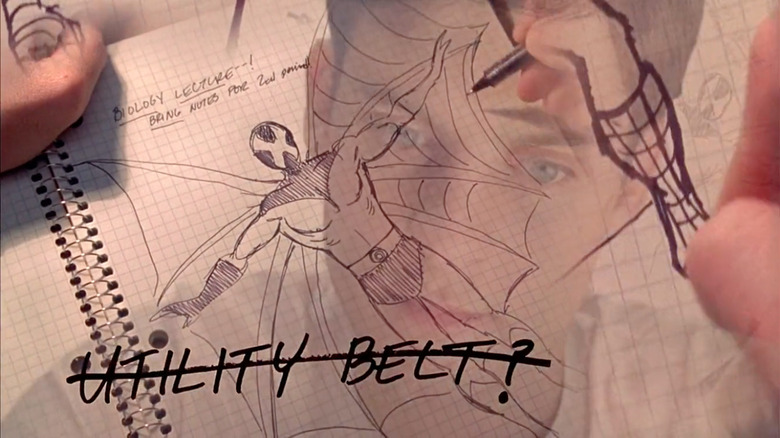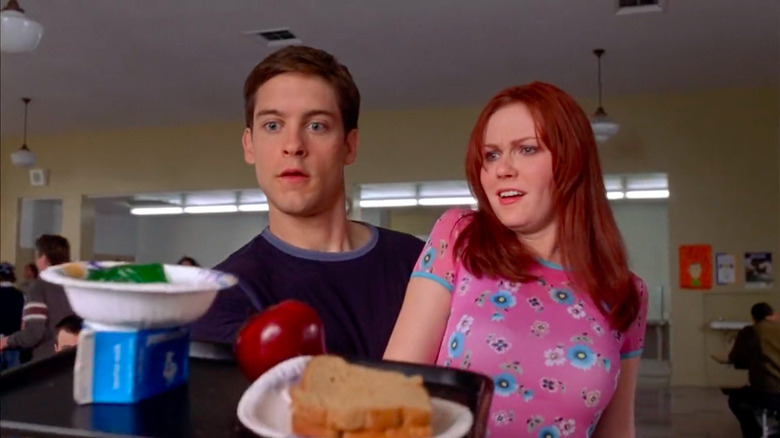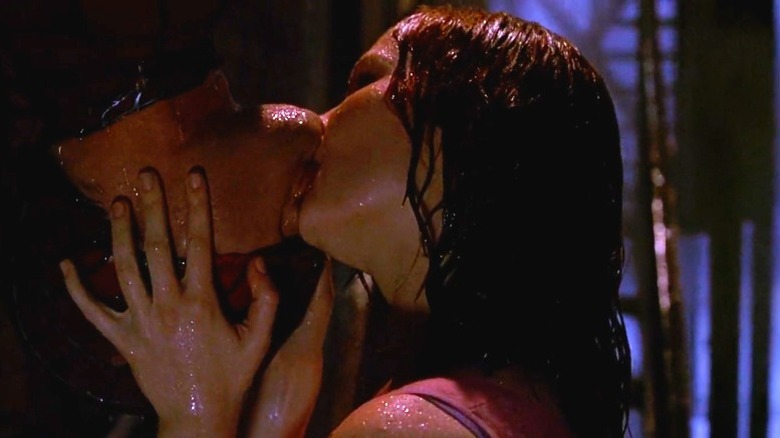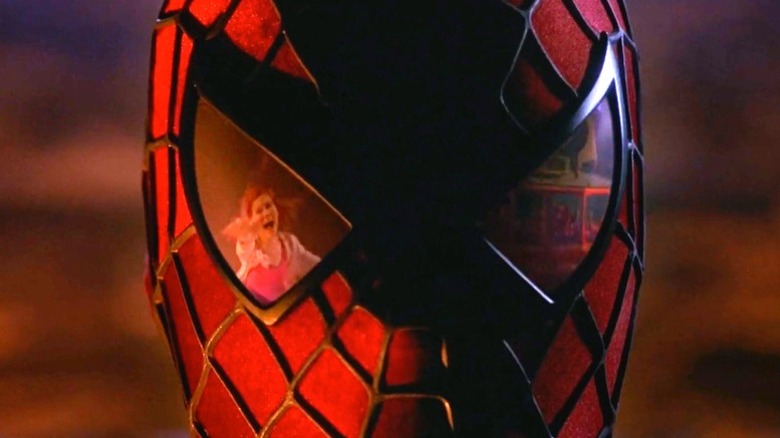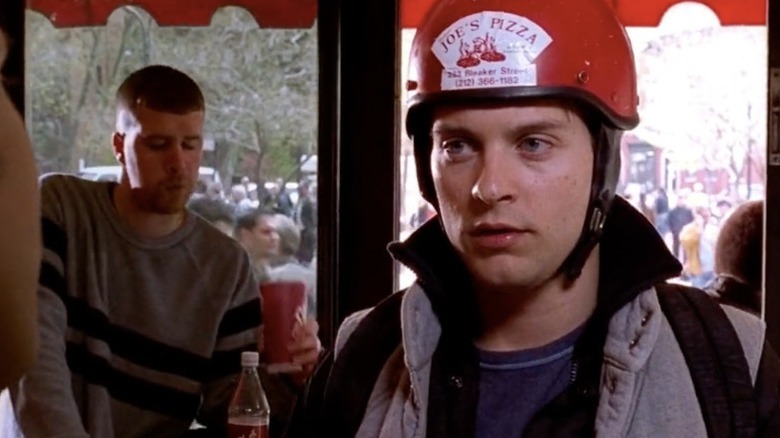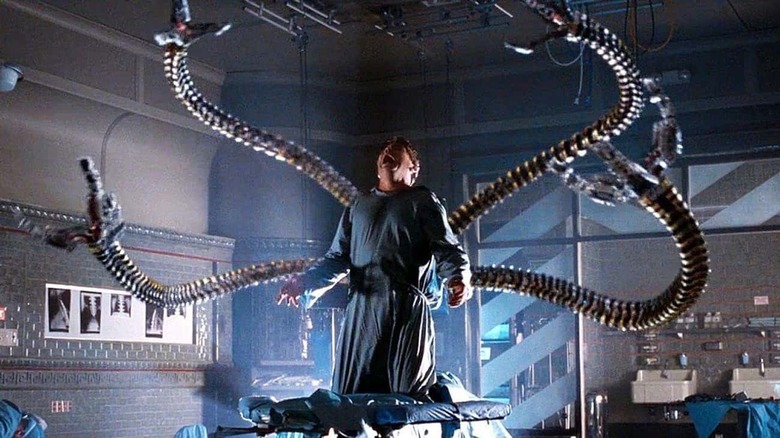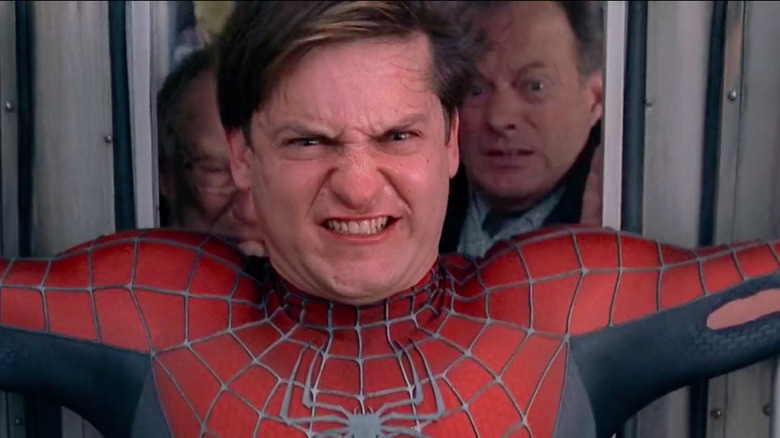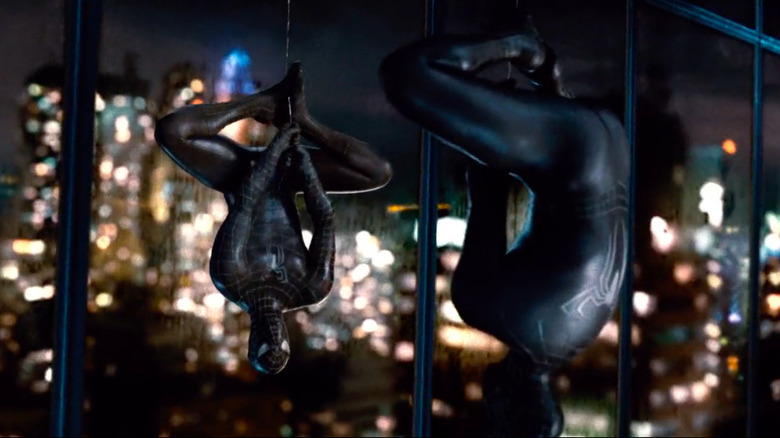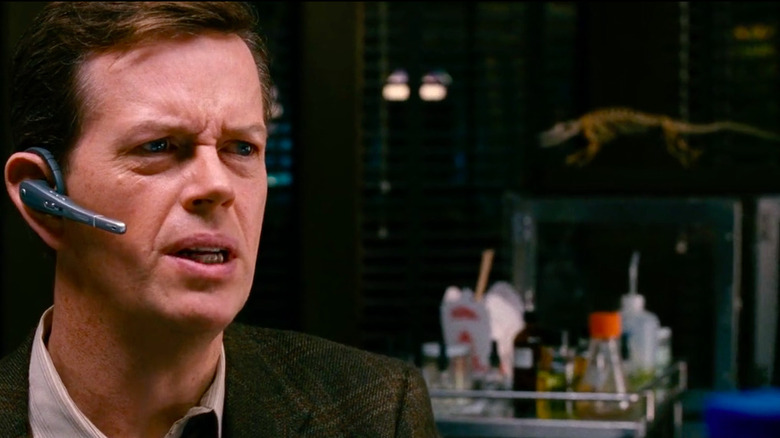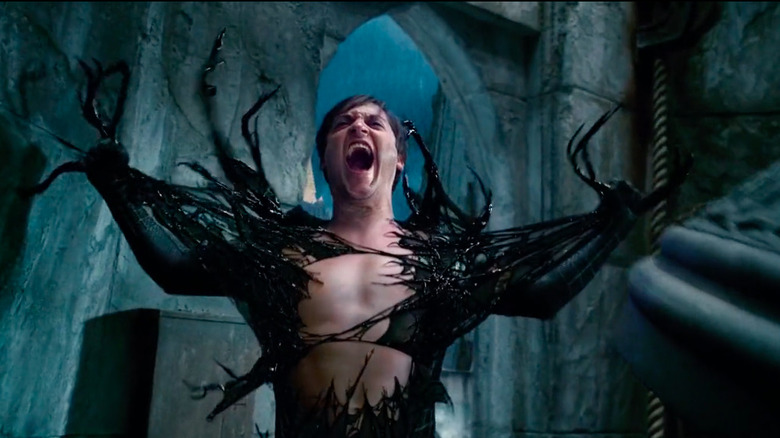The Most Paused Moments From Tobey Maguire's Spider-Man Trilogy
Before Tom Holland swung his way into the Marvel Cinematic Universe, and before Andrew Garfield fought Paul Giamatti in a rhino-shaped mech suit, Tobey Maguire defined Spider-Man on the big screen. Maguire perfectly captured the defining qualities of Peter Parker that made him such an inspiring hero. He managed to balance the dorkiness of everyday Parker with the extraordinary feats of the friendly neighborhood Spider-Man.
Maguire's Spider-Man films were the greatest superhero movies of the early 2000s, and they still hold up today. Director Sam Raimi deserves much of the credit for creating films that can stand shoulder-to-shoulder with everything that's come since. It's not just that Raimi understood his characters and the story that he was telling, but also that he had a great eye for stunning visuals. Maguire's Spider-Man trilogy looks just as good as modern Marvel blockbusters, despite the absence of today's CGI capabilities. Impressive wire work, brilliant practical effects, and expert shots all contribute to films that truly manage to bring the beauty of comic books to life. Take a trip back through the most paused moments in the original Spider-Man trilogy to properly relive the superhero magic Maguire and Raimi brought to the big screen decades ago.
Designing the suit
When Tobey Maguire's Peter Parker is first designing his suit, he's going for style more than practicality. Peter needs a costume to compete in a wrestling match with a $3,000 prize, so he can buy a car to impress Mary Jane. A brief montage shows that while Peter only needs the costume for a night, he still puts quite a bit of thought into its look. An early draft features web-like wings and a symbol that's vaguely reminiscent of another Marvel superhero who will get her first solo film almost two decades later. Peter also apparently considers giving his costume a utility belt. This gets scrapped from the final design, likely after Peter considers that gadgets won't be allowed in the ring.
Despite all the detailed designs that Peter draws up, he's wearing a spray painted t-shirt and a red ski mask when he shows up to face off against Bonesaw. Presumably Peter's lofty ambitions came up against a lack of funds. Considering that he never ends up buying a car, it's possible that Peter spent his prize money on the costume that he wears for the remainder of the film.
Catching lunch
Throughout Tobey Maguire's Spider-Man trilogy, the titular hero saves Mary Jane from various dangers on a regular basis. As Peter is still coming to terms with his new powers in the first movie, he gets the opportunity to save MJ from a small-scale danger in the high school cafeteria. Peter catching MJ and her lunch after a slip is one of the most iconic moments from 2002's "Spider-Man." It was a trailer moment that still managed to impress when seen in theaters.
By now, most fans know that the shot was done practically and Maguire actually caught the entire lunch on a tray. Reportedly, Sony didn't want to keep the scene in the film at all, but Raimi insisted it stay, partly because the scene ate up a sixteen hour day and took Maguire 156 takes to pull off (via Cinemablend). Unsurprisingly, the director made the right call, and this is still one of the best examples of Peter using his powers in any Spider-Man film to date.
Upside down kiss
Peter and MJ's first kiss is probably the most iconic moment of Tobey Maguire's first Spider-Man film, and it's one of the most memorable superhero movie kisses of all time. MJ gets attacked by two muggers in a dark New York City alley, and Peter arrives to save her so quickly that he doesn't even have time to put on his mask. Luckily, the darkness covers his face, and he ducks away to properly hide his identity, but he can't help coming back for a chat with MJ after the rescue.
While Peter hangs upside down from a strand of web, MJ thanks him for saving her life. She pulls his mask halfway down his face. Their kiss defined superhero romance for a generation. When Peter kisses MJ without his mask later in the film, she realizes that he's been Spider-Man all this time (because his voice wasn't a dead giveaway). The upside down kiss has been referenced and parodied into oblivion, but it will forever be a part of the Spider-Man mythos.
Bridge rescue
There's no doubt that Sam Raimi's direction has a lot to do with how good Tobey Maguire's Spider-Man trilogy turned out. Raimi perfectly understood Peter Parker and his superhero alter-ego. He had a deep knowledge of the comics his movies were based on, and, not for nothing, he knows how to put together a beautiful shot.
At the climax of 2002's "Spider-Man," the Green Goblin takes MJ and a trolley full of children hostage above a New York City bridge. Spider-Man is forced to choose between saving the love of his life or dozens of innocent lives. The moment echoes the comic story "The Night Gwen Stacy Died" and gives Peter one of his biggest moral dilemmas in the entire trilogy. Raimi perfectly captures Peter's moment of indecision by showing MJ and the trolley reflected in the eyes of Spider-Man's costume. It may be the only time Spider-Man's eye coverings are shown to be reflective, and the wide shot just before implies that this perfect reflection would be impossible — but when a stunning and thematic shot is available, why let realism get in the way?
Peter's pizza delivery helmet
"Spider-Man 2" is usually referred to as the best of Sam Raimi's trilogy. It features a great new villain, some stunning action set pieces, and the best character development in the franchise. Much of the film focuses on Peter's struggle to balance his "real life" with his Spider-Man life, which leads into an adaptation of the "Spider-Man No More!" storyline from the comics.
At the beginning of the film, Peter is working as a delivery man for Joe's Pizza. He drives a moped around the city and wears a red helmet adorned with a Joe's Pizza sticker. It just so happens that Joe's Pizza is a real establishment in New York City, and some eagle-eyed fans noted that the phone number and address listed on Peter's helmet sticker are for the real life Joe's. That's some surprising attention to detail, especially since the very same sticker misspells "Bleecker Street" as "Bleeker Street." Joe's Pizza has moved away from Bleecker Street since 2004, but people can still catch a slice at a variety of locations throughout the city.
Doc Ock's full reveal
Doctor Octopus is one of Spider-Man's greatest villains, so it made sense for "Spider-Man 2" to choose Doc Ock as its villain. Unlike the Green Goblin, who was primarily set up as a mad man on the hunt for some revenge, Doc Ock is a tragic character who makes a fairly sympathetic antagonist for the film. Dr. Otto Octavius is a scientist working on creating a special kind of fusion reactor that could create sustainable energy for the entire planet. He creates four metal, AI-powered arms to assist him in managing his fusion reactor, but an accident that leads to the death of his wife also destroys the inhibitor chip that prevents his metal arms from controlling his mind.
The arms awaken in one of the few truly horrifying scenes in the Spider-Man trilogy. Sam Raimi gets to show off his horror director background as the arms lash out and kill a team of doctors who were trying to remove them from Otto's body. After the attack, Otto wakes, surrounded by bodies and fully under the influence of the AI arms. Doc Ock is born in an unforgettable moment, and Alfred Molina's performance was so iconic that Marvel tapped him to return in "No Way Home" 17 years later.
Stopping the train
Despite its heavy focus on Peter Parker's internal turmoil, "Spider-Man 2" also boasts one of the best action scenes in any Spider-Man film. After making a deal with Harry Osborne, Doc Ock sets off to capture Spider-Man. After a brief tussle on top of a clocktower, Doc Ock and Spider-Man go head-to-head on a speeding elevated train.
Doc Ocks leaves the scene as the train speeds towards a deadly drop at the end of its line. A maskless Spider-Man is left to find a way to stop the train and save everyone on board. The rescue takes every ounce of strength that Spider-Man has and leaves him incapacitated. Tobey Maguire's face while stopping the train has been meme'd to death, but in the context of the film his strain is deeply moving. After struggling with his powers the entire film, this is the moment that Peter truly steps up and becomes the hero he needs to be. The New Yorkers aboard the train return Spider-Man's mask and promise to keep his identity a secret just before Doc Ock returns to capture the hero and bring him back to Harry.
Black suit reveal
"Spider-Man 3" was maligned by critics and fans alike. The film was criticized for having too many villains, an unbalanced plot, and altogether too many cringe-worthy musical numbers, but that doesn't mean it was entirely without redeeming qualities. In spite of some serious missteps, there are still some killer moments in "Spider-Man 3," and the first look at Spider-Man's black suit tops the list.
Unless someone entirely skipped looking at the trailers or poster for "Spider-Man 3", the appearance of the black suit surprised no one, but Sam Raimi still managed to make the suit's reveal impactful. The symbiote is seen crawling up Peter Parker's body as he lays in bed, and Peter opens his eyes just as the black ooze covers his face. The screen cuts to black, but then the camera pulls back through the black mesh of the new suit to reveal Spider-Man hanging from a skyscraper with mirror-like windows. Christopher Young's score blares as the suit is shown in its full glory. Comic fans everywhere were thrilled, and the shot is so good it almost makes up for the hour long wait for the suit –- almost.
Lizard foreshadowing in Dr. Connors's office
Tobey Maguire's and Sam Raimi's "Spider-Man 4" didn't hit the big screen, but it was very much in the works at Sony, even after the disastrous critical reception of "Spider-Man 3". Raimi apparently planned for the Vulture to be the main villain for his Spider-Man finale, but fans have long wondered if another classic Spider-Man foe could have made the cut. Dr. Curtis Connors first appeared in "Spider-Man 2" and immediately grabbed the attention of comic book readers. In the comics, and later in "The Amazing Spider-Man," Connors becomes the infamous Lizard.
In "Spider-Man 3" there's a "blink and you miss it" moment of foreshadowing Dr. Connors's fate. Over the phone the professor is giving Peter an update on his examination of the symbiote, though Dr. Connors is entirely unaware that Peter is already intimately aware of what the symbiote can do. The camera cuts to show Dr. Connors examining his research in his office, and as he slides his chair to take a look at a computer monitor, a lizard skeleton can be seen over his shoulder. The shot doesn't confirm that Dr. Connors would make his monstrous transformation in the ill-fated "Spider-Man 4," but it's just enough to excite the imaginations of Lizard fans.
Removing the symbiote
Seeing Spider-Man's black suit on the big screen was incredibly satisfying, but seeing Peter rip his way free from it was equally as great. By the end of "Spider-Man 3," the black suit had put Peter, and the film's audience, through more than a handful of painful situations. From the traumatic pseudo-death of Flint Marko to the even more traumatic street dancing scene, the black suit had caused enough damage that no one was sad to see it go.
At the top of a church belltower, Peter finally discovers the symbiote's only weakness: Loud sounds. The bell causes just enough disruption in the symbiote that Peter is able to wrench himself free of its influence. His struggle with the web-like black strands of the symbiote is one of the more visually compelling moments of the film, and seeing Peter return to his usual self is a delight –- even if it means that Topher Grace will have to be Venom for the last thirty minutes of the film. There's no doubt that the black suit story could have been handled much better, but at least it looked great all the way through.
